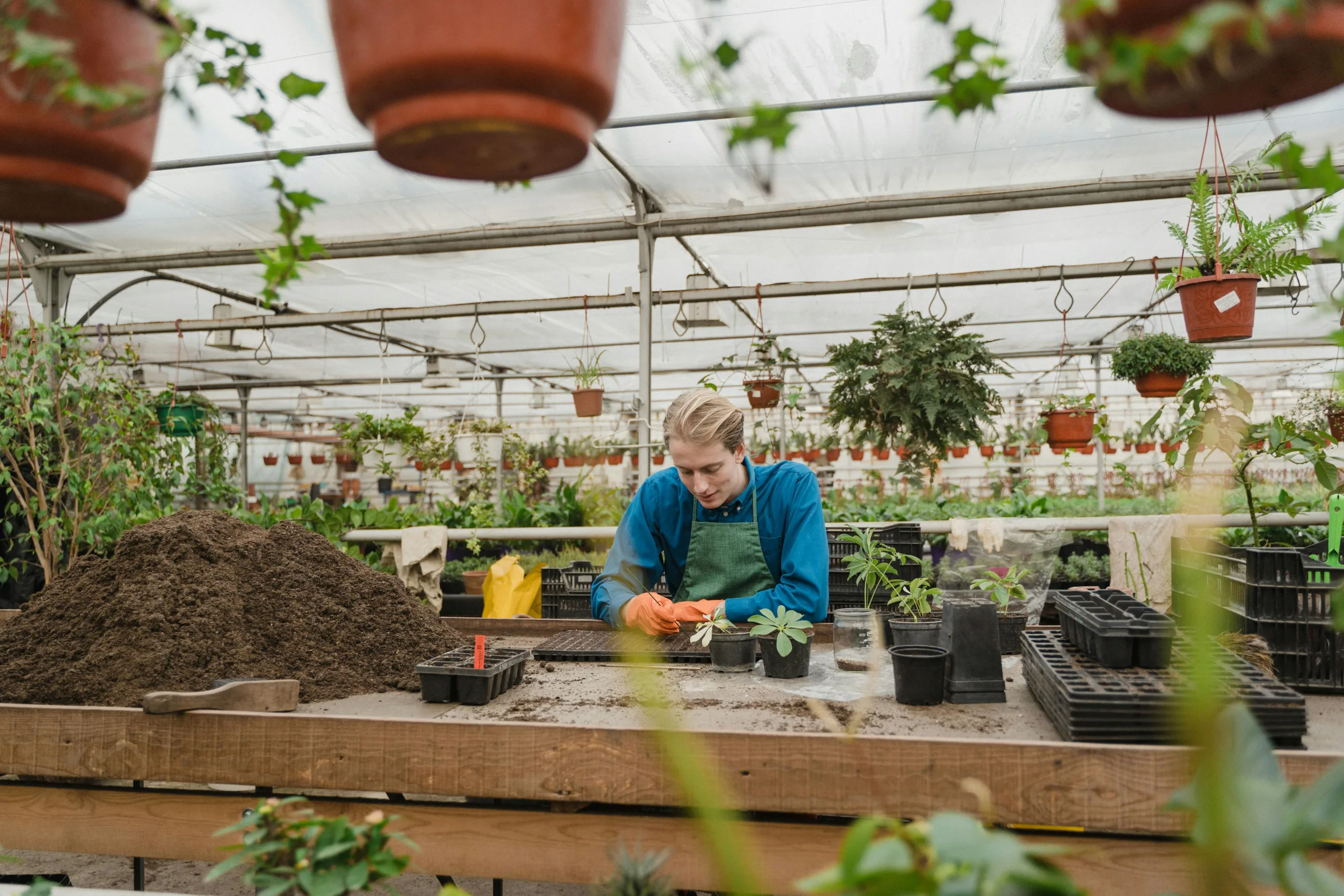Get Your Hands Dirty with Practical Horticulture Skills
If you’re ready to truly learn by doing, this highly practical course is the perfect place to start. The Practical Horticulture Course is designed to immerse you in real-world gardening tasks—whether you’re a beginner or keen home gardener. Through hands-on activities, you’ll gain the essential skills and confidence needed to grow, maintain, and care for a wide variety of plants. It’s not just theory—it’s training you can take straight into the garden.
There are lots of practical horticultural tasks to develop your skills and knowledge covered in this course. So if you are a student that prefers practical learning, then this course is the ANSWER, and it really does work!
What You’ll Learn:
-
Plant Identification: Recognize and classify a variety of plant species.
-
Soil Management: Understand soil properties and how to improve soil health.
-
Plant Nutrition: Learn about essential nutrients and fertilization techniques.
-
Water Management: Develop efficient irrigation strategies for different plants.
-
Pest and Disease Control: Identify common plant pests and diseases and explore control methods.
-
Pruning Techniques: Master the art of pruning for plant health and aesthetics.
-
Propagation Methods: Discover various propagation techniques to multiply your plants.
-
Garden Design Basics: Gain insights into planning and designing functional garden spaces.
Course Features:
-
100% Online: Study at your own pace from anywhere.
-
Expert Tutor Support: Receive personalized guidance from experienced horticulturists.
-
Practical Assignments: Engage in real-world tasks to apply your knowledge.
-
Flexible Payment Options: Choose a payment plan that suits your budget.
-
Certificate of Completion: Earn a certificate to showcase your new skills.
Who Should Enrol
-
Aspiring gardeners seeking foundational knowledge.
-
Homeowners aiming to enhance their garden spaces.
-
Individuals considering a career in horticulture.
-
Anyone passionate about plant care and sustainability.
Enrol Today
Take the first step towards a greener future. With flexible learning options and expert support, our Practical Horticulture A course is your gateway to mastering the essentials of plant care and garden management.
Practical Horticulture Course Outline
There are 10 lessons in this course:
- Soil Analysis
- Soil Analysis
- Testing Your Soil
- Good Soil Structure
- Simple Soil Test
- Naming The Soil
- Percolation Rates
- Drainage Problems
- Soil Temperature
- How to Improve Soils
- Soil pH
- Methods Of Measuring Ph
- Probe Meters
- Colorimetric Methods
- pH meters
- Another Way to Measure Organic Matter in Soil
- Terminology
- Seed Propagation (including seed identification)
- Growing Plants from Seed
- Hygiene
- How to Sow Seeds in Containers
- Germination
- Preparation of Seed Beds in the Field
- Selected Plant Species
- Seed Propagating Media
- General Characteristics
- Cation Exchange Capacity
- Seed Compost
- Commonly Used Mixes
- Terminology
- Vegetative Propagation
- The Techniques
- Classification Of Cutting Types
- Equipment
- Procedures For Taking Cuttings
- Types Of Cuttings
- Stem Cuttings
- Herbaceous Cutting
- Tip Cutting
- Heel Cutting
- Nodal Cutting
- Basal Cutting
- Cane Cutting
- Leaf Cutting Techniques
- Root Cutting
- Bulb Cuttings
- Improving Strike Rate
- Terminology
- Potting up and After Care of young plants
- Transplanting Between Pots
- Stop Roots Growing into The Soil
- What is a Perched Water Table?
- Drainage Holes
- Potting Up a Plant
- Potting Up Cuttings
- Pricking Out or Tubing Seedlings
- Setting out Cuttings
- Potting up a hanging basket
- Porous pots need different treatment
- Plant Modification to Achieve Uniformity
- Modification Techniques
- Spacing
- Staking
- Growing-On Areas for Container Plants
- Chemical Growth Modification
- Planting
- General Planting Considerations
- Problems With Containers
- How To Maintain Plants in Pots
- Types Of Pots
- Bare Rooted Plants
- Planting
- Hints For Planting
- Drainage
- Improving Infiltration of Water into The Soil
- Improving Surface Drainage After Construction
- Provision Of Sub Surface Drains
- Layout Of Drains
- Outlet
- Gradients
- Distance Between Drainage Pipes
- Depth Of Drains
- Types Of Drains
- Laying The Drain
- Surface Drainage
- Some Points to Remember When Designing a Drainage System
- Terminology
- Maintenance of Established Plants
- Pruning In the Home Garden
- The Basic Rules of Pruning
- Getting Pruned
- Selecting Your Secateurs
- Winter Pruning
- General Principles
- How To Do It
- Pruning Tools
- Some Examples of Winter Pruning
- Pollarding
- Plants That Respond Well to Pruning Include:
- How To Prune a Rose
- Clean Out Your Dead Wood
- Wood Rots
- Dead Heading
- Is Annual Pruning Enough?
- What Is Compartmentalisation?
- What About Wound Treatments?
- What About Compost – Doesn’t It Spread Disease?
- Pruning In the Home Orchard
- Terminology
- How To Use Trimmers
- Pruning Tomatoes
- Root Pruning
- How To Trim a Hedge
- Training
- Terminology
- Practical Plant Identification – Woody Plants
- Plant Names
- Common Names
- Scientific Names
- What Is the Difference Between Families
- Common Names
- Scientific Names
- What Is the Difference Between Families
- Pest, Disease and Weed Identification
- Pests
- Diseases
- Diagnosis of Problems
- Finding Out What the Problem Is
- Conducting An Inspection
- Tell Tale Symptoms
- Is There More Than One Problem?
- Develop A Systematic and Logical Approach to Inspecting the Plant
- Conducting An Inspection
- Diagnosis Of Plant Disorders
- Shortcuts To Problem Identification
- Difficult To Diagnose Problems
- Integrated Pest Management (IPM)
- Weeds
- Common Terms
- Practical Plant Identification – Non-Woody Plants Including Grasses and Indoor Plants
- Choosing The Right Lawn
- Turf Varieties
- Lawn Mixes
- What To Grow Where
- Cool Winters/Dry Summers
- Mild Summers/Cold Winters
- Fescues, Kentucky Blue Grass, Rye Grass, Couch.
- Tropical
- Bulbs
- What Spring Bulbs Need
- How To Grow Bulbs
- Bulbs In Subtropical and Tropical Areas
- Indoor Plants
- Potting
- Risk Assessment
- Identifying Risk in The Workplace
- Chainsaw Use & Safety
- Save The Back, Use the Head! Hard Work Solutions
- Cleaning & Sharpening Tools
- Secateurs And Branch Pruning Tools
- Shovels And Spades
- Saws And Chainsaws
- Protecting Tools from Rust
- Maintaining Timber Handles
- Maintaining Plastic Handles
- Storage
Each lesson culminates in an assignment which is submitted to the school, marked by the school’s tutors and returned to you with any relevant suggestions, comments, and if necessary, extra reading.

